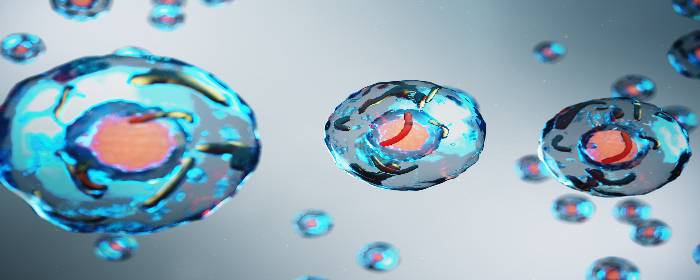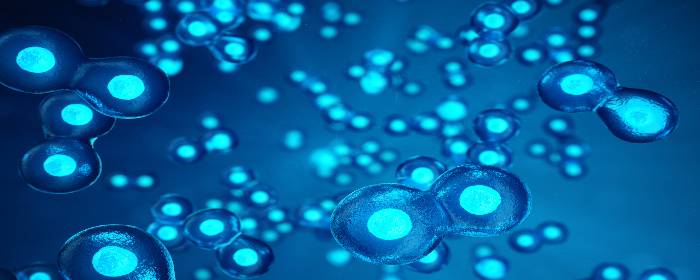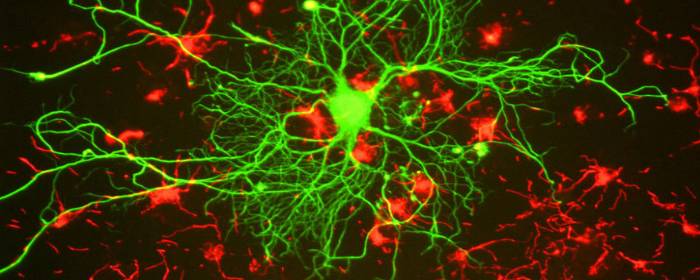
by admin | May 16, 2019 | Mesenchymal Stem Cells, Multiple Sclerosis, Stem Cell Research, Stem Cell Therapy
A new study has shown that a protocol for treating Multiple Sclerosis with stem cells is safe. According to the researchers, the potential for using stem cells in Multiple Sclerosis therapy warrants further investigation. The results of the study were published in the Journal of Translational Medicine.
Stem cells – and specifically, mesenchymal stem cells, have been increasingly used in the treatment of immune and inflammatory conditions. Based on the success that has been seen in these areas, scientists reasoned that mesenchymal stem cells may also represent a useful approach to treat Multiple Sclerosis, a neurological disease that involves the abnormal attack by the immune system on the myelin sheath that insulates nerves and allows nerve cells to communicate effectively and efficiently with one another.
To test this idea, the scientists used umbilical cord mesenchymal stem cells in 20 Multiple Sclerosis patients. The patients were given intravenous injections of the stem cells each day for seven days. The researchers evaluated the patients – with both neurological testing and nervous system imaging – at baseline, one month after treatment, and one year after treatment. The researchers found that the stem cell treatment improved neurological scores in patients and that lesions in the brain and cervical spinal cord were inactive one year after the stem cell injections. There were no serious adverse side effects associated with the treatment.
Based on these findings, it is possible that stem cells will provide a useful treatment option for those with Multiple Sclerosis. With more research, we will better understand exactly how stem cells can be used to help this population of patients.
Reference: Riordan, N.H. et al. (2018). Clinical feasibility of umbilical cord tissue-derived mesenchymal stem cells in the treatment of multiple sclerosis. Journal of Translational Medicine, 16(57), 1-12.

by admin | Apr 8, 2019 | Stem Cell Research, Stem Cell Therapy, Umbilical Stem Cell
Much of the initial excitement surrounding stem cells was that they have the potential to become other types of cells. Add cardiac stem cells to a heart damaged by a heart attack, for example, and perhaps those stem cells will become new heart cells and restore heart function. While this does occur—stem cells differentiated mature into adult cells—a fascinating and potentially more exciting use of stem cells is for what they secrete rather than what they become.
Over the past few years, researchers have become increasingly interested in the beneficial substances that stem cells secrete. Researchers refer to the collection of substances that stem cell secretes as its secretome. Stem cell researchers grow various kinds of stem cells in the laboratory and then measure the substances that the stem cells secrete to identify its secretome.
Dr. Hsieh and coauthors discovered that stem cells taken from human umbilical cord secrete an astounding number of helpful molecules. The scientists collected mesenchymal stem cells from Wharton’s jelly (which is a substance found in the human umbilical cord that is normally thrown away as medical waste). They then compared those mesenchymal stem cells with stem cells taken from bone marrow. The researchers found that the umbilical cord mesenchymal stem cells produced molecules that help protect nerve cells, helps nerve cells grow, and help blood vessels grow. The effects were much greater than from cells taken from bone marrow.
One interesting result from their scientific study was the effect of umbilical cord mesenchymal stem cells on injured nerve cells. The researchers deprived brain cells of sugar and oxygen to mimic what the cells would experience during a stroke. The substances secreted by stem cells protected the nerve cells during this harsh treatment. This effect was much stronger in the umbilical cord stem cells compared to the bone marrow stem cells.
Another interesting result from this research was that umbilical cord mesenchymal stem cells helped blood vessel cells organize and form new blood vessels (“tubes”). This could be very important for establishing blood flow to damaged tissue from burns, frostbite, heart attack, or stroke.
These results show that mesenchymal stem cells taken from umbilical cord tissue (Wharton’s jelly) have a unique secretome, which is more potent than similar cells taken from bone marrow. This research is particularly important for patients who have suffered an ischemic stroke or heart attack, as it may provide a clue for a way to treat these conditions in the future.
Reference: Hsieh et al. (2013). Mesenchymal Stem Cells from Human Umbilical Cord Express Preferentially Secreted Factors Related to Neuroprotection, Neurogenesis, and Angiogenesis. PLOS One.2013; 8(8): e72604.

by admin | Mar 29, 2019 | Mesenchymal Stem Cells, Stem Cell Research, Stroke, Umbilical Stem Cell
An ischemic stroke is a devastating event. An ischemic stroke is caused when a blood clot blocks blood flow to a portion of the brain. If the blood cannot deliver oxygen and nutrients, brain cells in the affected area die. Whatever functions that area of the brain once performed are now lost—brain cells do not regenerate the same way as other cells do.
Not surprisingly, researchers are trying to find ways to restore dead brain cells so that patients can regain function. Stem cells are one of the most promising options in this pursuit. Stem cells can reduce brain damage caused by ischemia (lack of blood flow, nutrients, and oxygen). Moreover, stem cells can help animals with stroke regain neurological function.
Scientists have wondered, however, whether mesenchymal stem cells taken from the umbilical cord can achieve the same effects. Umbilical cord tissue is plentiful and the cells taken from the umbilical cord have many incredible properties.
Dr. Zhang and researchers in his group extracted mesenchymal stem cells from umbilical cord tissue collected from humans. This umbilical cord tissue is usually thrown away after a baby is born, but researchers have been collecting this material because it is rich in mesenchymal stem cells. The researchers then created ischemic strokes in rats by blocking one of the arteries to the brain. They then used stem cells to try to block the damaging effect of stroke in these rats.
The stem cells were given to the rats intravenously. The stem cells moved from the bloodstream into the brain and collected in the area of the stroke. Some of the stem cells actually became new brain cells in the damaged area. Moreover, rats treated with stem cells had better physical functioning than animals who did not receive stem cell treatment.
While this study was performed in rats, the implications for humans are profound. This work shows that mesenchymal stem cells taken from the umbilical cord are capable of improving function after stroke. This is exited news since it is much easier to obtain stem cells from umbilical cord tissue that it is from bone marrow (which requires an invasive procedure).
Reference: Zhang, Lei et al. (2017). Neural differentiation of human Wharton’s jelly-derived mesenchymal stem cells improves the recovery of neurological function after transplantation in ischemic stroke rats. Neural Regeneration Research. 2017 Jul; 12(7): 1103–1110.

by admin | Feb 1, 2019 | Adipose, Exosomes, Mesenchymal Stem Cells, Stem Cell Research, Stem Cell Therapy, Studies, Umbilical Stem Cell
Most organs of the body recover from injury by generating new, healthy cells. Not every organ of the body has the same ability to form new cells, however. The skin is an example of an organ that has an amazing ability to regenerate. Liver and lung also have the ability to form new cells, but not as dramatically as skin. Kidney and heart have even less ability to repair and regenerate. On the opposite end of the spectrum from the skin is the brain, which has very little capacity to regenerate once it has been damaged or destroyed. All of these organ systems, especially those that are relatively unable to repair themselves, could theoretically benefit from stem cells.
Mesenchymal stem cells, also known as stromal cells, are multipotent stem cells derived from bone marrow, umbilical cord, placenta, or adipose (fat) tissue. These cells can become the cells that make up bone, cartilage, fat, heart, blood vessels, and even brain. Mesenchymal stem cells have shown a remarkable ability to help the body to produce new cells. Researchers are now realizing that the substances stem cells release may be more important than any new cells they may become. In other words, stem cells can directly become new healthy cells to a certain degree, but they can also release substances that dramatically increase the number of new, healthy cells.
Mesenchymal stromal stem cells release small packets called exosomes. These exosomes are filled with various substances that promote cell and tissue growth. Some of the most interesting and potentially useful substances are cytokines and micro RNA. Cytokines are the traffic cops of cellular repair, signaling certain events to take place while stopping others. Having the right cytokines in a particular area is critical for new tissue growth. The micro RNA released by stem cell exosomes is potentially even more exciting than cytokines. These tiny bits of RNA can directly affect how healthy and diseased cells behave. Micro RNA has a powerful ability to control the biological machinery inside of cells.
Exosomes exhibit a wide array of biological effects that promote the repair and growth of damaged and diseased organs. They promote the growth of skin cells and help wounds heal. Exosomes can reduce lung swelling and inflammation and even help the lung tissue heal itself (i.e. reduced pulmonary hypertension, decrease ventricular hypertrophy, and improve lung vascular remodeling). These small packets released by stem cells help prevent liver cells from dying (i.e. prevents apoptosis), promote liver cell regeneration, and slow down liver cirrhosis (i.e. fibrosis). Exosomes can also help protect the kidneys during acute injury and reduce the damage that occurs during a heart attack.
Several clinical trials are underway designed to allow these exciting developments to be used to treat patients. As the researchers state, “Extensive research and clinical trials are currently underway for the use of MSCs as regenerative agents in many diseases including spinal cord injury, multiple sclerosis, Alzheimer’s disease, liver cirrhosis and hepatitis, osteoarthritis, myocardial infarction, kidney disease, inflammatory bowel disease, diabetes mellitus, knee cartilage injuries, organ transplantation, and graft-versus-host disease.” We can reasonably expect that exosomes will be used to treat at least some of these conditions in the very near future.
Reference: Rani al. (2015). Mesenchymal Stem Cell-derived Extracellular Vesicles: Toward Cell-free Therapeutic Applications. Molecular Therapy. 2015 May; 23(5): 812–823.

by admin | Jan 4, 2019 | Stem Cell Research, Stem Cell Therapy, Studies
Spinal cord injury can be one of the most devastating
injuries. Long neurons that extend from the brain down the spinal cord are
severed and scarred. In most cases, this damage can never be repaired. If
patients survive an injury to the spinal cord, they can be permanently
paralyzed. Researchers have attempted to use high-dose steroids and surgery to
preserve the spinal cord, but these approaches are either controversial or
largely ineffective.
Ideally, one would create an environment in which nerve
cells in the spinal cord could regrow and take up their old tasks of sensation
and movement. One of the most promising approaches to do just this is stem cell
transplantation.
To test this concept, researchers used
stem cells derived from human placenta-derived mesenchymal
stem cell tissue (not embryonic stem cells) to form neural stem cells in
the laboratory. These neural stem cells have the ability to become neuron-like
cells, similar to those found in the spinal cord. The researchers then used
these stem cells to treat rats that had experimental spinal cord injury. The
results were impressive.
Rats treated with neural stem cells regained the partial
ability to use their hindlimbs within one week after treatment. By three weeks
after treatment, injured rats had regained substantial use of their hindlimbs.
The researchers confirmed that this improvement was due to neuron growth by
using various specialized tests (e.g. electrophysiology, histopathology). Rats
that did not receive stem cells did not regain substantial use of their
hindlimbs at any point in the study.
This work is particularly exciting because it shows that
stem cells can restore movement to animals who were paralyzed after spinal cord
injury. Moreover, the researchers used human stem cells derived from placenta,
which suggests that this effect could be useful in human spinal cord injury
patients (perhaps even more so than in rats). While additional work is needed,
these results offer hope to those who may one day develop severe spinal cord
injury.
Reference:
Zhi et al. (2014). Transplantation of placenta-derived
mesenchymal stem cell-induced neural stem cells to treat spinal cord injury.
Neural Regen Research, 9(24): 2197–2204.






 St. Petersburg, Florida
St. Petersburg, Florida
